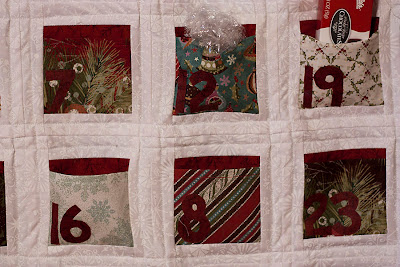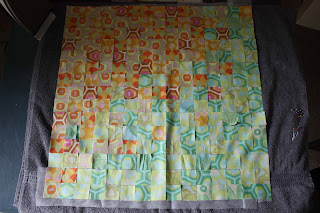**Previously published on my personal blog, this series of posts is aimed at explaining to non-quilters just what goes into making a quilt. Thought I'd move them over here to Type B**

Leanika by Dena Designs for Free Spirit Fabric
We covered the basics in the last post - quilting, what is it? In this post, we're going to talk about supplies and fabric. (Oh, how I love fabric!) What do you need to start quilting? Well, women in colonial times made do with the following:
But if you're quilting in the modern times, I'd suggest at minimum the following:
Selecting a sewing machine
And, of course, a
sewing machine. You want to buy the best machine you can afford. That doesn't mean that you need to get a $12,000 Bernina. The quilters in my family use machines from simple, mechanical machines from the 1950's up to the most high-tech computerized quilting and embroidery machines.
I have one computerized machine (the New Home/Janome on the left, purchased from craigslist) and one mechanical machine (the Juki TL98Q on the right). There is less to go wrong with a mechanical machine and they can stitch faster, but they have less options and need to be oiled after each use. On the other hand, computerized machines have more bells and whistles but need to be treated with a little more care.
A good idea is to make a list of must-have features (I wanted a zig-zag, needle-down position, feed dogs that you could lower, and a free-arm for clothes sewing) and then try to find the machine that is the best fit. Most important is that you are comfortable with the machine and know its quirks and kinks. Generally, if you have a bad first experience with your sewing machine, you will be less likely to continue sewing. So try some out before you take the plunge!
Take a look at
this post, as well, for beginning quilters.
This blog is having a great series on Sewing 101 (it reminded me that I forgot to say iron and ironing board in my supplies list - very important!)
On to fabric!
Some people collect antiques, stamps, or rare books - I collect fabric! The bulk is sitting in large bins in our storage unit in New Mexico, but I've been adding to my collection since I've moved to WI in 2009. At least it doesn't look like
this blogger's mom's stash! I have also finished six quilt tops and I'm working on a seventh - we'll call it my Fitchburg Period.
Leanika by Dena Designs for Free Spirit Fabric
It probably goes without saying, but fabric comes in different grades and qualities. Based on the way the fabric is woven, it will stand up to treatment differently (is it for a rough-and-tumble toddler/young child or for a wallhanging that will be spot-treated? Will it be in direct sunlight?). Think of it the same way you think about sheets and thread count; you can feel the difference. You can buy fabric at JoAnn's or Hancock's for $1.99-5.99/yard or you can buy it at a local quilt shop (LQS) for $9-$12/yard. What is going on there? There are a couple answers to that question
here and
here. Essentially, the quality of cotton used and the processes to fix the ink vary and quilts will wear differently (especially bright colors) over time. Many quilters use 100% cotton fabrics for quilting. Usually, though not always, you will be able to feel the quality, just by touching the fabric.
House by Annette Tatum for Free Spirit Fabric
I recommend buying what you can afford - don't let cost hold you back from any creative endeavor! Remember that the first quilts were made of left-over clothes and linens (more well-to-do women did intricate whole cloth quilts to show off their stitch work). Perhaps it goes without saying, of course, that those early quilts were also made out of only natural fibers, as well. I've seen some great contemporary quilts from re-purposed clothes. If cost is a concern, I suggest buying reliable brand-name fabric from Fabric.com where quality fabric can be on sale for $4/yard (and if you spend $35, you get free shipping). You will be happier with the investment of your time and talents if you use the best quality you can afford. (I'm not going to jump whole hog into the Kona cotton debate - Joann's vs LQS, but here is what
Robert Kaufman fabrics has to say. I buy from everywhere.)
Fabric comes in lines released similar to clothing lines (i.e., the Calvin Klein Summer 2010 line of swimwear). Christmas fabrics tend to come out in the summer, so people can get their holiday projects finished in time. The lines have matching colors, coordinating patterns and variation between large, medium, and small prints. Reliable name-brands - Moda, Kaufman, Hoffman, Timeless Treasures, Thimbleberries, Westminster/Free Spirit, Alexander Henry, Michael Miller, Riley Blake, etc.
Moda pre-cuts - Verna, Neptune, Fresh Air, and Panache lines
One way to get started if you are overwhelmed by choosing fabric is to use pre-cuts. Moda has a "bakery line" which includes one to two pieces of each fabric design in a line. In the photo above you can see jelly rolls (40-2.5" strips), honey buns (40-1.5" strips), charm squares (40-5" squares), and layer cakes (40-10" squares). (Not pictured are turnovers - 6" triangles, which I believe are not being made anymore? Also honey buns seem to be on their way out...).
Moda Bake Shop is a great blog where guest bloggers provide free patterns and tutorials using these precut items. Pre-cuts save you some time cutting (duh!), but often you pay more per-yard, if you do the math. I try to buy them only when they are on sale. Another great way to get started - quilt kits, which include a pattern and all the fabric needed to make the top - easy, peasy.
Kona Cotton from Hancock's of Paducah and JoAnn Fabric
Here are some places that I like to buy fabric (and patterns):
Fabric.com (this is kind of like the TJ Maxx of fabric stores)
Fat Quarter Shop
Hancock's of Paducah (a huge store in a quilting town that hosts the American Quilting Society's Quilt Show each April)
JoJo's Gift Shoppe
Burgundy Buttons
Pink Chalk Fabrics
Amazon.com (sells fabric for other shops, but if you use
Swagbucks to earn $5 giftcards, you can basically work up to free fabric, if you are very patient and don't buy books first! Using Swagbucks and a Groupon-type deal, I purchased a Parisville FQ bundle for less than $30!)
There are many others and I just keep my eye open for items that are on-sale from various newsletters that I receive.
Next up - Assembly (if I get the quilt assembled, that is!).

























































